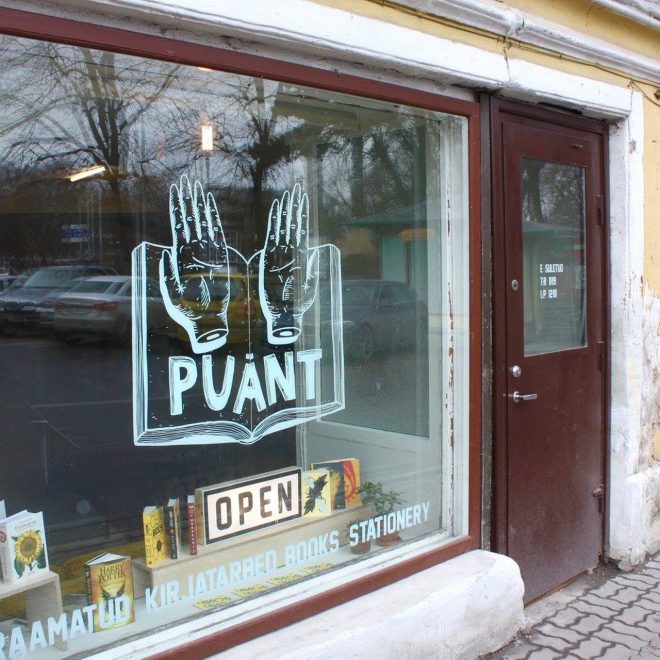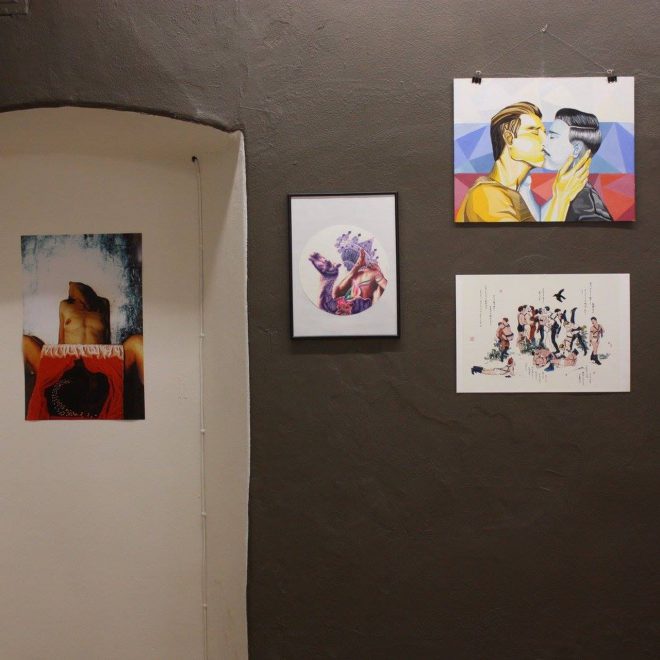Queer Traces: Transnational Queer Underground’s #TheGalleryProject
Ben Miller talks with Verena Spilker about a Berlin-based project that raises questions about how to create more inclusive archives and how communities can form through art.

Transnational Queer Underground’s “#TheGalleryProject: Exhibition Nº 1” was on view March 10 – 24, 2017, at Raamatupood Puänt in Tallinn, Estonia.
Editor's Note
When queer people express themselves, writes José Esteban Muñoz in Cruising Utopia: The Then and There of Queer Futurity, “there is often a gatekeeper [to mainstream culture]…who will labor to invalidate the historical fact of queer lives—past, present, and future.” Traditional forms of archival evidence, like formally documented histories, are often absent from or irrelevant to queer lives; instead, he suggests, we must turn to “traces” of queer life present in the margins.
How then can these individual traces be woven into networks that bind queers together, that help us survive? Transnational Queer Underground (TQU), a Berlin-based project founded in 2009 by queer activist Verena Spilker, came from her research into the Riot Grrrl and Queercore movements. Last spring, Spilker put out a call for submissions to a new online archive called #TheGalleryProject, a sub-project of TQU that serves as an un-curated space for queer people to display work and build an artistic and political community. After receiving and posting the work of 46 artists from around the world, Spilker mounted an offline exhibit from March 10 - 24, the first of several across Europe, as part of Ladyfest in Tallinn, Estonia. Each stop of the exhibition will be accompanied by workshops where visitors create work in conversation with the pieces shown. #TheGalleryProject offers an alternative to more institutionalized efforts to highlight queer artists by challenging the ways archives and museums selectively place value on artistic works.
Last month, I sat down with Spilker in her cheerful kitchen in Neukölln; we drank coffee out of Bette Davis and Joan Crawford mugs and discussed curating, the canon, and the political value of queer art.
—Ben Miller
Ben Miller: Did you find that the works in #TheGalleryProject organized themselves around themes?
Verena Spilker: The only theme was the diversity we have as a queer community, as many different people with different ideas and different approaches—so many different ways of presenting yourself and the world around you.
BM: A lot of what excites me about this project has to do with its lack of curation and also with the ways in which audiences are invited to participate in the creation of their own work. It sems to flatten all these hierarchies in a way that’s particularly useful to your cultural and political project. How do you relate the project of community building and programs like workshops (what we might call “political” work) to the presentation of the art itself?
VS: I am curious about how people perceive the exhibition and it’s hard to get responses from people who just come and visit. So I like the idea of setting up at least one workshop per exhibition so there can be a response from people in every country towards the artwork.
After looking at the work, participants in Tallinn sat down and thought about how they would imagine a queer utopia, what important things they struggle with. We paired them up and they talked about their presents and futures and made drawings to represent their thoughts. The workshop involved these ideas about utopian ideals and how to access them, making allegorical maps of how to reach from the present state to the utopian future and what we might see there.

Installation view of Transnational Queer Underground’s “#TheGalleryProject: Exhibition Nº 1” at Raamatupood Puänt in Tallinn, Estonia. Courtesy the artists.
BM: How does this project in your view relate to curating, to the concept of the canon, to the idea of value in art?
VS: The project is an attempt to question those concepts. Everyone who sent work in got a chance to exhibit online and in person. Most of the TQU as well as #TGP is about questioning existing structures and trying to find ways that operate outside of traditional ways of working and traditional ways of defining artistic value. What we have is a super-Westernized canon where a lot of [modes of artistic expression used by queer people, and particularly queer people of color] are not even considered art. This project can be anything—tattooing even!
If you come from a rich background or have both a good job and time to create on the side, that’s great, but most of us have to struggle to survive and to find time to create work. We are also trying to find ways to monetarily validate the art that is part of #TGP, to create merch to sell, where every artist would get an equal share regardless of whose work sold.
BM: Have you seen this project’s potential for organizing and self-care take root?
VS: Yes, it’s just beginning. For example: Two people from Indonesia saw the call and had never made any art before. One is a woman who photographed herself nude and burning the Koran. The other is a trans* woman who had a lot of trouble transitioning and who was dealing with her body in photographs. I hope that the exhibition inspires people to know that there is a community that you can participate in online and through art even if you don’t have one around you.
Editor's Note
Transnational Queer Underground’s “#TheGalleryProject: Exhibition Nº 1” was on view March 10 – 24, 2017, at Raamatupood Puänt in Tallinn, Estonia.



